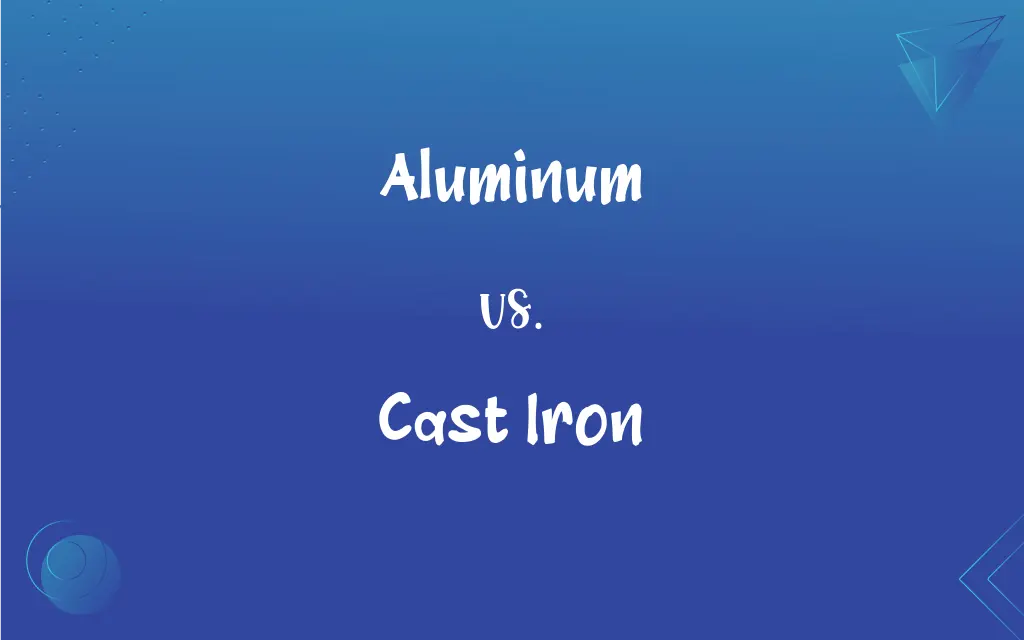Aluminum vs. Cast Iron: What's the Difference?
Edited by Harlon Moss || By Janet White || Updated on October 31, 2023
Aluminum is a lightweight, malleable metal, while Cast Iron is a heavier, brittle alloy primarily composed of iron and carbon.

Key Differences
Aluminum is a silvery-white metal known for its lightweight properties. It's soft, non-magnetic, and is used in a vast range of applications. Cast Iron, on the other hand, is a hard and brittle material, typically gray or black, that has a high carbon content, making it very strong under compression.
Aluminum is highly malleable, which means it can be easily formed into various shapes without breaking. This quality makes it perfect for industries like packaging or airplane manufacturing. Cast Iron, conversely, does not have this malleability. While it can be molded when melted, once it solidifies, it becomes very rigid, which is why it's often used for heavy-duty structures and tools.
In terms of heat conduction, Aluminum stands out. It conducts heat efficiently, making it ideal for kitchenware like pots and pans. Cast Iron retains heat for longer periods, which is why cast iron skillets are praised for their even heating and heat retention properties.
Aluminum is resistant to corrosion due to the formation of an oxide layer on its surface when exposed to air. This protective layer keeps it from deteriorating quickly. Cast Iron, however, can rust when exposed to moisture, requiring seasoning or coatings for protection.
Lastly, in the environment, Aluminum is abundant, comprising about 8% of the Earth's crust. It's frequently recycled due to its ease of reprocessing. Cast Iron, being an alloy, isn't naturally occurring, but it's made by melting iron and adding a specific amount of carbon, along with other elements if needed.
ADVERTISEMENT
Comparison Chart
Composition
Pure metal element
Alloy of iron with 2-4% carbon
Weight
Lightweight
Heavy
Malleability
Highly malleable
Brittle and rigid
Heat Conductivity
Efficient heat conduction
Retains heat longer
Corrosion Resistance
Resists corrosion due to oxide layer
Can rust and needs protection
ADVERTISEMENT
Aluminum and Cast Iron Definitions
Aluminum
Aluminum is a soft, lightweight metal.
Aluminum cans are commonly used for beverages.
Cast Iron
Cast Iron is hard and brittle.
Cast Iron benches are sturdy but can crack if dropped.
Aluminum
Aluminum is the third most abundant element in the Earth's crust.
Bauxite is the primary ore from which Aluminum is extracted.
Cast Iron
Cast Iron can be found in various grades based on its carbon content.
Gray and white are two common types of Cast Iron.
Aluminum
Aluminum is highly resistant to corrosion.
Aluminum boats don't rust easily in salty water.
Cast Iron
Cast Iron can be seasoned to prevent rusting.
A seasoned Cast Iron skillet has a shiny, non-stick surface.
Aluminum
Aluminum is easily recyclable.
Many Aluminum products get melted down and reused multiple times.
Cast Iron
Cast Iron is an iron alloy with high carbon content.
Cast Iron skillets are popular for cooking due to their heat retention.
Aluminum
Aluminum is a good conductor of electricity and heat.
Aluminum wiring is often used in residential properties.
Cast Iron
Cast Iron has a characteristic granular fracture.
When Cast Iron breaks, it exhibits a rough, grainy surface.
Aluminum
A silvery-white, ductile metallic element, the most abundant in the earth's crust but found only in combination, chiefly in bauxite. Having good conductive and thermal properties, it is used to form many hard, light, corrosion-resistant alloys. Atomic number 13; atomic weight 26.9815; melting point 660.32°C; boiling point 2,519°C; specific gravity 2.70; valence 3. See Periodic Table.
Cast Iron
Made of cast iron.
Aluminum
Standard spelling of aluminium
Cast Iron
Rigid; inflexible
A cast-iron rule.
Aluminum
The metallic element forming the base of alumina. This metal is white, but with a bluish tinge, and is remarkable for its resistance to oxidation, and for its lightness, having a specific gravity of about 2.6. Atomic weight 27.08. Symbol Al. Also called aluminium.
Cast Iron
Exceptionally strong or resistant
A cast-iron stomach.
Aluminum
A silvery ductile metallic element found primarily in bauxite
Cast Iron
Alternative spelling of cast iron
Cast Iron
Alternative spelling of cast iron
Cast Iron
Made of cast iron. Hence, Fig.: like cast iron; hardy; unyielding.
Cast Iron
Extremely robust;
An iron constitution
FAQs
What is Aluminum?
Aluminum is a lightweight, malleable, silvery-white metal.
Why do Cast Iron skillets need seasoning?
Seasoning protects Cast Iron from rust and provides a non-stick surface.
Is Aluminum expensive?
Generally, Aluminum is less expensive than many metals, but its price can vary based on market conditions.
How is Cast Iron different from pure iron?
Cast Iron is an alloy of iron and carbon, making it harder and more brittle than pure iron.
What is the primary use of Cast Iron?
It's widely used for cookware, machinery, pipes, and automotive parts.
Why is Aluminum used in aircraft?
Because of its lightweight and strength properties.
How do you clean Cast Iron?
Clean it with a mild detergent, dry it thoroughly, and then oil it to protect it.
Is Aluminum good for cooking?
Yes, due to its efficient heat conduction, but it can react with certain foods.
Can you weld Cast Iron?
Yes, but it requires specific techniques due to its brittle nature.
Why is Cast Iron heavy?
Due to its dense molecular structure and high carbon content.
Can Aluminum be painted?
Yes, but it often requires a special primer.
How is Aluminum produced?
It's extracted from bauxite ore and then refined using the Bayer process.
Is Aluminum recyclable?
Yes, and it's one of the most recycled metals due to its ease of reprocessing.
Does Aluminum rust like iron?
No, Aluminum forms an oxide layer preventing further corrosion.
Is Cast Iron safe for cooking?
Yes, especially when well-seasoned, as it prevents food from contacting iron directly.
How do you protect Cast Iron from rust?
By seasoning it or coating it with oil or paint.
Is Aluminum magnetic?
No, Aluminum is non-magnetic.
What gives Cast Iron its dark color?
Its high carbon content and the formation of iron carbides.
What are the health effects of cooking with Cast Iron?
It can increase iron content in food, which is beneficial for those with iron deficiencies but can be excessive for others.
Why is Aluminum used in power lines?
Because it's a good conductor of electricity and is lighter than copper.
About Author
Written by
Janet WhiteJanet White has been an esteemed writer and blogger for Difference Wiki. Holding a Master's degree in Science and Medical Journalism from the prestigious Boston University, she has consistently demonstrated her expertise and passion for her field. When she's not immersed in her work, Janet relishes her time exercising, delving into a good book, and cherishing moments with friends and family.
Edited by
Harlon MossHarlon is a seasoned quality moderator and accomplished content writer for Difference Wiki. An alumnus of the prestigious University of California, he earned his degree in Computer Science. Leveraging his academic background, Harlon brings a meticulous and informed perspective to his work, ensuring content accuracy and excellence.

































































